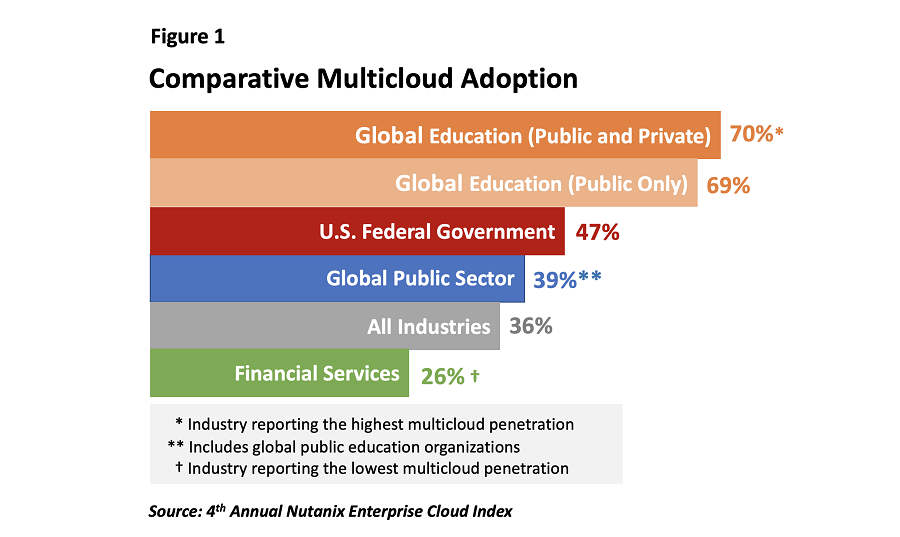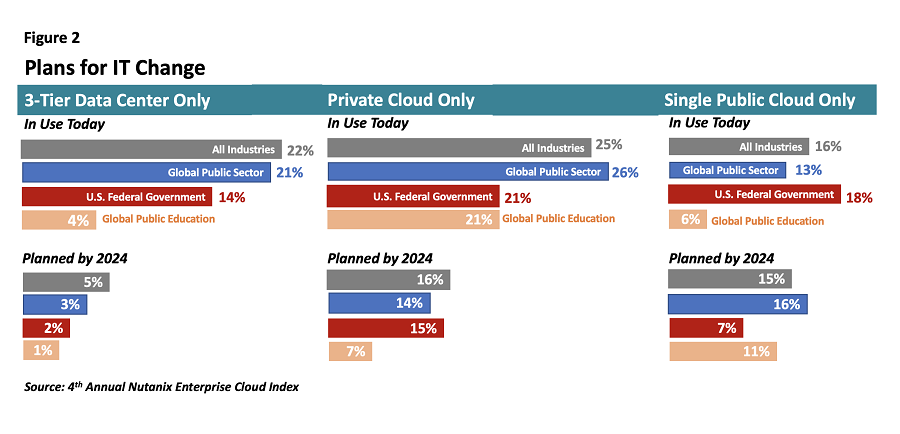Government entities are among the quickest to embrace multicloud IT models.
More organizations in this sector – most notably in public education and U.S. federal agencies – have adopted mixed-cloud environments than other industries, according to research conducted by U.K. firm Vanson Bourne for Nutanix.
More than two-thirds (69%) of respondents in public education and 47% of those in U.S. federal organizations reported that they’re currently running multiple private and/or public clouds as their “primary IT environment.”
These adoption levels compared to 39% of the overall global public sector market and 36% of the full cross-industry base of 1,700 IT professionals polled for the 4th Annual Nutanix Enterprise Cloud Index report, shown in Figure 1.

These organizations’ multicloud growth plans also outpace the averages: by 2024, 67% of all global public respondents, 76% of U.S. federal respondents, and 79% of global public education respondents expect multicloud to be their primary operating model. These projections compared to 64% of all cross-industry respondents who expect to be running multiclouds within three years.
Agencies in Transition
While multicloud was the dominant IT infrastructure across the public sector and globally, most organizations also reported other IT setups in use. They indicated plans to winnow these down as they work to integrate separate infrastructure into a unified multicloud with common management, application mobility, and global policy-setting and enforcement.
The greatest evidence of planned change was in the reduction of traditional three-tier data centers and private clouds, as Figure 2 shows.

When it came to public clouds, only the U.S. federal sub-sector said it expects its use of a single public-cloud IT infrastructure to notably drop within three years (from 18% today to 7% in 2024). Global public sector and education sub-sector respondents anticipate that their public cloud use will actually increase during that time, while overall, global respondents see public cloud use shrinking marginally.
The near-term increase in public cloud usage reflects an evolution in organizations that are earlier in their multicloud journeys. It’s often the addition of public cloud to existing on-premises infrastructure that brings them into the multiple-cloud realm.
Deloitte Consulting defines the journey for government entities as having three main phases: solving the technical and security problems that hinder cloud adoption, sorting out competing IT priorities, and maximizing the cloud mission. Before the pandemic, according to Deloitte, some agencies got stuck in phase 2, as they struggled to stretch their budgets across legacy infrastructure maintenance and IT modernization through cloud adoption.
Government Multicloud Motivators
The worldwide pandemic served as a cloud accelerator, particularly in education, where home learning became the sole option for more than a year.
“The pandemic broke the cycle of perpetual consideration and pushed many more agencies into the third era,” wrote Deloitte authors in early 2022.
It also triggered increased sharing of data across agencies and governments in order to manage critical programs worldwide for vaccination development, research, testing, and tracing, according to global tech consultancy Capgemini.
In early 2022, the firm reported a shift in the public sector “toward accessing data outside the traditional departmental boundary, rather than ‘owning’ it directly. This is gathering pace as the public sector perceives the benefits it brings, including real-time access, agility, cost and accuracy, and finds compliant ways to achieve them.”
In the 4th Annual Nutanix ECI research, the reason global public sector (40%) and public education (60%) respondents gave most often for their planned adoption of multiple clouds was to better support remote workers and collaboration. However, among U.S. federal government organizations, that driver (38%) was second to a desire to gain the ability to scale the IT organization more easily and on demand (41%).
Forbes contributor Bernard Marr observed that uptake in hybrid and multiple clouds is in part due to many entities “growing past their first forays into cloud computing, and having established the benefits...and looking for additional use cases. This has resulted in many companies finding themselves in a ‘multi-cloud’ environment, using a number of services, sometimes from several different suppliers.”
Cloud-Smart Trends
The U.S. 2019 Federal Cloud Computing Strategy, dubbed Cloud Smart, is a long-term cloud strategy for U.S. federal agencies. It’s being recognized by other organizations as a more sound strategy than its “cloud-first” predecessor, which involved moving IT assets, more or less indiscriminately, as quickly as possible into a public cloud environment.
By contrast, cloud smart means using cloud infrastructure both on-premises and operated by a third party, depending on the application and its requirements. For example, the global public sector indicated that public cloud was most often their preferred location for eight typical run-the-business applications, such as databases, customer relationship management (CRM), human resources, and enterprise resources planning (ERP). However, private cloud was frequently the same group’s preference for a given infrastructure's ability to support a more general use case or achieve a certain business outcome, such as managing IT costs, complying with regulatory mandates, and ensuring fast application performance.
Early phases of multicloud adoption often involve using third-party cloud infrastructure for data backup and infrastructure redundancy. Brent Ellis of Forrester, for example, recommended diversity across clouds as an approach to resilience in a blog late last year following outages in all the major public cloud provider infrastructures.
“Diversify your risk by building applications and services that can be shifted between multiple cloud providers or private infrastructure automatically as a service fails,” he advised. “You don’t have to replicate your entire stack in an alternate provider to mitigate some of your cloud vendor concentration risk.”
For example, he advocated using a “secondary cloud provider for disaster recovery as a service, data backup, and basic office applications in the event of an extended outage or some event that impacts the reliability of your primary cloud.”
Joanie Wexler is a contributing writer and editor with more than 25 years of experience covering the business implications of IT and computer networking technologies.
© 2022 Nutanix, Inc. All rights reserved. For additional legal information, please go here.




